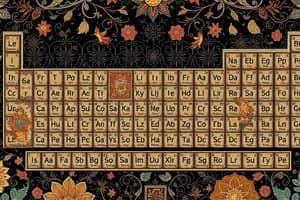Podcast
Questions and Answers
Which property makes aluminium suitable for use in aeroplane bodies?
Which property makes aluminium suitable for use in aeroplane bodies?
- Good electrical conductor
- Antibacterial properties
- Resistant to corrosion
- High strength-to-weight ratio (correct)
Copper is known for its reactivity and is always found in pure forms.
Copper is known for its reactivity and is always found in pure forms.
False (B)
What is the main property of copper that makes it ideal for electrical wiring?
What is the main property of copper that makes it ideal for electrical wiring?
Very good conductor of electricity
Aluminium is used for _____ because it is a good thermal conductor.
Aluminium is used for _____ because it is a good thermal conductor.
Match the following metals with their primary uses:
Match the following metals with their primary uses:
Which property of aluminium makes it resistant to corrosion?
Which property of aluminium makes it resistant to corrosion?
Food cans made from aluminium are non-toxic and resistant to acidic food stuffs.
Food cans made from aluminium are non-toxic and resistant to acidic food stuffs.
Name one property of copper that makes it suitable for use in pots and pans.
Name one property of copper that makes it suitable for use in pots and pans.
What is produced when zinc reacts with steam?
What is produced when zinc reacts with steam?
Gold reacts readily with oxygen to form a metal oxide.
Gold reacts readily with oxygen to form a metal oxide.
What is the general reaction when a metal reacts with an acid?
What is the general reaction when a metal reacts with an acid?
When calcium reacts with water, it forms __________ and hydrogen gas.
When calcium reacts with water, it forms __________ and hydrogen gas.
Which of the following metals does NOT react with oxygen?
Which of the following metals does NOT react with oxygen?
Match the following reactions with their products:
Match the following reactions with their products:
All metals react with water to produce hydrogen gas.
All metals react with water to produce hydrogen gas.
What type of metal is known for reacting easily with oxygen?
What type of metal is known for reacting easily with oxygen?
What is an alloy?
What is an alloy?
Alloys are chemically combined substances.
Alloys are chemically combined substances.
Name one use of brass.
Name one use of brass.
Stainless steel is an alloy of iron and __________.
Stainless steel is an alloy of iron and __________.
Which of the following statements is true regarding the properties of alloys?
Which of the following statements is true regarding the properties of alloys?
An alloy of aluminium that is stronger yet has a low density is ideal for __________ production.
An alloy of aluminium that is stronger yet has a low density is ideal for __________ production.
Match the following alloys with their primary properties or uses:
Match the following alloys with their primary properties or uses:
What type of structure do alloys have compared to pure metals?
What type of structure do alloys have compared to pure metals?
What property allows metals to conduct heat and electricity?
What property allows metals to conduct heat and electricity?
All non-metals are brittle when solid.
All non-metals are brittle when solid.
What is the primary type of bond present in metals?
What is the primary type of bond present in metals?
Most metals possess _____ melting and boiling points due to the strong electrostatic attraction.
Most metals possess _____ melting and boiling points due to the strong electrostatic attraction.
Match the following metals to their properties:
Match the following metals to their properties:
Which of the following is an exception among non-metals that can conduct electricity?
Which of the following is an exception among non-metals that can conduct electricity?
All elements in the Periodic Table are either metals or non-metals.
All elements in the Periodic Table are either metals or non-metals.
What happens to metallic character as you move left to right across the Periodic Table?
What happens to metallic character as you move left to right across the Periodic Table?
Metalloids, also known as _____, exhibit both metal and non-metal properties.
Metalloids, also known as _____, exhibit both metal and non-metal properties.
Which of these properties is not characteristic of metals?
Which of these properties is not characteristic of metals?
Flashcards
Metals
Metals
Elements that are good conductors of heat and electricity due to their delocalised electrons, which are able to freely move throughout the metal structure.
Malleability
Malleability
The ability of a substance to be hammered into different shapes without breaking.
Ductility
Ductility
The ability of a substance to be drawn into wires.
Metallic Bonding
Metallic Bonding
Signup and view all the flashcards
Melting Point
Melting Point
Signup and view all the flashcards
Boiling Point
Boiling Point
Signup and view all the flashcards
Non-metals
Non-metals
Signup and view all the flashcards
Brittleness
Brittleness
Signup and view all the flashcards
Reactivity Series
Reactivity Series
Signup and view all the flashcards
Alloys
Alloys
Signup and view all the flashcards
Metals + Cold Water
Metals + Cold Water
Signup and view all the flashcards
Metals + Steam
Metals + Steam
Signup and view all the flashcards
Metals + Acids
Metals + Acids
Signup and view all the flashcards
Metals + Oxygen
Metals + Oxygen
Signup and view all the flashcards
Metal Oxide
Metal Oxide
Signup and view all the flashcards
Metal Hydroxide
Metal Hydroxide
Signup and view all the flashcards
Replacement Reaction
Replacement Reaction
Signup and view all the flashcards
Oxidation of Metals
Oxidation of Metals
Signup and view all the flashcards
Why does aluminium appear unreactive?
Why does aluminium appear unreactive?
Signup and view all the flashcards
Why is aluminium used in aeroplane bodies?
Why is aluminium used in aeroplane bodies?
Signup and view all the flashcards
Why is copper used in electrical wiring?
Why is copper used in electrical wiring?
Signup and view all the flashcards
Why is copper used in pots and pans?
Why is copper used in pots and pans?
Signup and view all the flashcards
Why is copper used in water pipes?
Why is copper used in water pipes?
Signup and view all the flashcards
Why is copper used in hospital surfaces?
Why is copper used in hospital surfaces?
Signup and view all the flashcards
What does it mean for a metal to be above hydrogen in the reactivity series?
What does it mean for a metal to be above hydrogen in the reactivity series?
Signup and view all the flashcards
What does it mean for a metal to be below hydrogen in the reactivity series?
What does it mean for a metal to be below hydrogen in the reactivity series?
Signup and view all the flashcards
What is an alloy?
What is an alloy?
Signup and view all the flashcards
What is brass?
What is brass?
Signup and view all the flashcards
What is stainless steel?
What is stainless steel?
Signup and view all the flashcards
How do the properties of alloys compare to the pure metals they contain?
How do the properties of alloys compare to the pure metals they contain?
Signup and view all the flashcards
What is the difference in structure between alloys and pure metals?
What is the difference in structure between alloys and pure metals?
Signup and view all the flashcards
Are alloys compounds or mixtures?
Are alloys compounds or mixtures?
Signup and view all the flashcards
How can you identify an alloy in a particle diagram?
How can you identify an alloy in a particle diagram?
Signup and view all the flashcards
How does the lattice structure of a metal change in an alloy?
How does the lattice structure of a metal change in an alloy?
Signup and view all the flashcards
Study Notes
Properties of Metals
- Metals are one of two broad types of elements found on the Periodic Table.
- Most elements are metals.
- Some elements display properties of both metals and non-metals; these are called metalloids or semimetals.
- Metals are generally good conductors of heat and electricity. This is because the electrons within a metal are delocalized and free to move.
- Metal layers can slide past each other easily. This makes metals malleable (can be hammered into different shapes) and ductile (can be drawn into wires).
- Metals typically have high melting and boiling points. This is due to the strong electrostatic attraction between positively charged metal ions and the delocalized electrons (metallic bonding).
Properties of Non-Metals
- Non-metals are the other broad type of element.
- Most non-metals are poor conductors of heat and electricity. This is because their electrons are involved in covalent bonding. This means they are not free to move around the material.
- Non-metals are usually brittle and break easily when solid.
- Non-metals tend to have low melting and boiling points compared to metals, as the weak intermolecular forces holding the molecules together require less energy to overcome.
- Exceptions to the above exist - for example graphite, a non-metal, is a conductor of electricity.
Chemical Properties of Metals
- Metal reactivity is studied by their reaction with water, dilute acids, and oxygen.
- Based on reaction experiments, a reactivity series can be produced.
Reactions of Metals with Different Substances
- Water: Some metals react with cold water, steam, and/or warm water. The reaction products depend on whether cold water or steam was involved—a metal hydroxide and hydrogen, or a metal oxide and hydrogen.
- Acids: Most metals react with acids producing salt and hydrogen gas.
- Oxygen: Metals react with oxygen to produce metal oxides; reactivity varies significantly between metals.
Uses of Metals
- Aluminium: Used in aeroplane bodies, overhead power cables, saucepans, and food cans due to its high strength-to-weight ratio, low density, and good electrical/thermal conductivity. The protective aluminium oxide layer also accounts for its resistance to corrosion (often appearing 'unreactive').
- Copper: Used in electrical wiring, pots and pans, water pipes, and hospital surfaces due to its excellent electrical conductivity, ductility, non-toxicity, and resistance to corrosion.
Alloys
- An alloy is a mixture of a metal and one or more other elements (often metals, but sometimes non-metals).
- Alloys often have enhanced properties compared to their constituent metals. For example, alloys are typically stronger, harder, and more resistant to corrosion compared with pure metals.
- The structure of an alloy typically involves a distorted arrangement of atomic layers, or different-sized atoms in the mixture. This distortion makes it harder for the layers to slide past each other and decreases the metal's ability to be deformed.
Studying That Suits You
Use AI to generate personalized quizzes and flashcards to suit your learning preferences.




